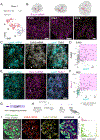Runx1 controls auditory sensory neuron diversity in mice
- PMID: 36800995
- PMCID: PMC10202259
- DOI: 10.1016/j.devcel.2023.01.008
Runx1 controls auditory sensory neuron diversity in mice
Abstract
Sound stimulus is encoded in mice by three molecularly and physiologically diverse subtypes of sensory neurons, called Ia, Ib, and Ic spiral ganglion neurons (SGNs). Here, we show that the transcription factor Runx1 controls SGN subtype composition in the murine cochlea. Runx1 is enriched in Ib/Ic precursors by late embryogenesis. Upon the loss of Runx1 from embryonic SGNs, more SGNs take on Ia rather than Ib or Ic identities. This conversion was more complete for genes linked to neuronal function than to connectivity. Accordingly, synapses in the Ib/Ic location acquired Ia properties. Suprathreshold SGN responses to sound were enhanced in Runx1CKO mice, confirming the expansion of neurons with Ia-like functional properties. Runx1 deletion after birth also redirected Ib/Ic SGNs toward Ia identity, indicating that SGN identities are plastic postnatally. Altogether, these findings show that diverse neuronal identities essential for normal auditory stimulus coding arise hierarchically and remain malleable during postnatal development.
Keywords: Runx1; auditory; cochlea; diversity; neuronal; neuronal identity; plasticity; spiral ganglion neurons.
Copyright © 2023 Elsevier Inc. All rights reserved.
Conflict of interest statement
Declaration of interests The authors declare no competing interests.
Figures






References
-
- Shrestha BR, and Goodrich LV (2019). Wiring the Cochlea for Sound Perception. In The Oxford Handbook of the Auditory Brainstem, Kandler K, ed. (Oxford University Press; ). 10.1093/oxfordhb/9780190849061.013.1. - DOI
Publication types
MeSH terms
Substances
Grants and funding
LinkOut - more resources
Full Text Sources
Other Literature Sources
Molecular Biology Databases

